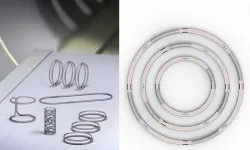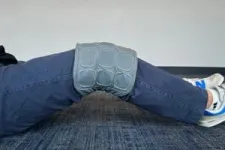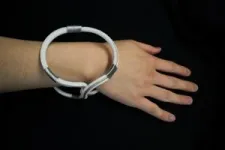(Press-News.org) In recent years, the field of metamaterials has experienced substantial growth, revealing exciting potential, especially in advancing magnetic resonance imaging (MRI) technology. Three new studies led by Dr. Xin Zhang, a BU College of Engineering Distinguished Professor and a professor at the BU Photonics Center, highlight the promising opportunities within this field. These studies, in collaboration with Dr. Stephan Anderson, a BU Chobanian & Avedisian School of Medicine professor of radiology, published in Advanced Science, Advanced Materials, and Science Advances, showcase innovative approaches to enhance the MRI experience for all patients. From integrating metamaterials with computer-aided embroidery technology to the development of wireless, lightweight coils adaptable to 3D curved body contours using coaxial cables, each paper offers its own distinct strategy. In this Q&A, Dr. Zhang discusses how her work is shaping the future of MRI technology by blending comfort, precision, and affordability.
What are metamaterials, and how do the research findings discussed in the Advanced Science, Advanced Materials, and Science Advances articles suggest they can enhance MRI technology?
Metamaterials, constructed from assemblies of multiple precisely designed structures at the subwavelength scale, have emerged as a powerful tool for tailoring the effective properties of materials by manipulating the amplitude, phase, and polarization of propagating waves. These materials have found widespread applications, including cloaking devices, perfect absorbers, wireless power transfer, and high-sensitivity sensing. Due to their unique capacity for electromagnetic field confinement and enhancement, metamaterials offer a new perspective on boosting the imaging performance of MRI in a wireless and cost-effective manner. Briefly, metamaterials are composed of arrays of unit cells featuring electromagnetic resonators, whose coupling leads to synergy and a collectively resonating mode. In the context of MRI, this synergy ultimately leads to a dramatic increase in the signal-to-noise ratio (SNR) of MRI and thus significantly improves the performance of MRI.
What is new and noteworthy about your findings?
In this work, we pioneered the use of off-the-shelf coaxial cables to construct form-fitting coils and conformal metamaterials for MRI applications. Coaxial cables, characterized by an inner conductor surrounded by a concentric conducting shield, with the two separated by a dielectric layer, provide efficient signal transmission and protection against external interference. By minimizing dielectric loss and capacitive detuning, these delicately designed resonators can preserve a high quality factor and demonstrate robustness against loading variations when imaging conducting samples in an MRI system. In contrast to previously reported MRI metamaterials, the coaxially-shielded metamaterials offer a substantial SNR gain due to their remarkable magnetic response and the suppressed electric dipole moment found in conventional metamaterials. Leveraging the inherent flexibility and electric field-confining properties of coaxial cables, these coils function wirelessly as additive components with the body coil, enhancing MRI imaging power.
Your Advanced Materials study introduces the concept of wireless MRI coils made from coaxial cables. How do these coils address the limitations of traditional coil arrays, and what advantages do they offer?
For many years, conventional anatomy-specific RF receive coils have been routinely used in MRI to provide high sensitivity in signal acquisition. However, their bulky, fixed, and rigid configurations often lead to patient discomfort, difficult positioning, and compromised signal sensitivity in certain scenarios. Additionally, the necessity for specific coil designs targeting particular anatomical areas has resulted in imaging centers maintaining 5–7 separate coils, significantly increasing costs. To address these challenges, our research introduces a groundbreaking solution — wireless, lightweight, coaxially-shielded and conformal metamaterials that can accommodate anatomies of various sizes. The proposed coaxial resonators demonstrate versatility by functioning both independently in form-fitting configurations, closely adapting to relatively small anatomical sites, and collectively by inductively coupling together as metamaterials. This allows for the extension of the field-of-view (FOV) coverage to encompass larger anatomical regions.
In what ways do the coil designs presented in the Science Advances study enhance patient comfort during MRI scans?
The coils presented in Science Advances enhance patient comfort in three key aspects. Firstly, the wireless design of these coils reduces positioning constraints and requires fewer adjustments, allowing for greater flexibility in patient positioning while maintaining signal strength and image quality. Secondly, the coils are designed in compact and form-fitting configurations, enabling them to be easily snapped or placed onto the arm, wrist, or ankle without the need for additional tools or fasteners. Lastly, the ultra-lightweight nature of these coils, with the proposed coaxial coils weighing only tens of grams, further enhances patient comfort.
Are there any challenges associated with implementing the technologies described in these papers? If so, how might you address them in future studies?
The current fabrication of coils and metamaterials relies on 3D printing, embroidery machines, and manual soldering and assembly. While these methods are convenient for iterative design refinement, they may be inefficient for large-volume production and potential commercialization. An improvement could involve upgrading the fabrication process to utilize automatic coil winding systems and plastic injection molding. Future endeavors should focus on improving the tuning process for tunable coils. A potential improvement involves connecting these coils wirelessly to the MRI system to form an efficient feedback loop, achieving automatic and precise frequency matching. A limitation of note of the proposed coils is that they may not be compatible with parallel imaging due to their cable-free design. However, the proposed coils could provide a comparable or even better SNR than current commercially available surface coils at extremely low cost. The inexpensive, highly customizable coils have great potential of increasing the availability of lower cost MRI to society and finding many diverse applications throughout the MRI landscape.
How do the findings of these research papers pave the way for the next generation of MRI technology, and what impact could this have on clinical practice and patient care?
The ideal next-generation MRI coil would combine improved image quality, enhanced patient comfort, increased adaptability, and ease of implementation in clinical settings. Capitalizing on the coaxial cable’s minimized dielectric loss and optimal form-fitting design, these wireless conformal coils and metamaterials exhibit heightened sensitivity in signal acquisition. In addition to providing high image quality, these wireless, lightweight, and conformal coils enhance patient comfort and streamline the implementation process, ultimately improving patient throughput and overall efficiency in the imaging department. Furthermore, facilitated by metamaterials technology, these coils offer a solution to wirelessly assemble multiple coils for customizable field-of-view (FOV) coverage. This leads to a modular coil array system suitable for multiple application scenarios, eliminating the need for multiple expensive coils for each anatomical region. These combined features position them as a groundbreaking advancement in the realm of MRI technology.
What do you hope to study next?
In future studies, we aim to translate these coils into clinical practice to ensure the new technology is effectively integrated into clinical scenarios and improves patient outcomes. We will collaborate with healthcare professionals, including physicians and technicians, to gather insights and define the clinical problems this technology aims to address. Based on specific clinical requirements, such as the anatomical configurations of disease-related sites, the penetration depth of abnormalities, and the desired area of the region of interest, we will further customize the coil design, including their size, configurations, and assembly of units in metamaterials. Through an iterative process, we aim to develop advanced MRI coils that can be seamlessly integrated into everyday healthcare settings and existing clinical workflows to improve patient care.
Republishers are kindly reminded to uphold journalistic integrity by providing proper crediting, including a direct link back to the original source URL.
END
Unleashing the power of metamaterials to improve MRI imaging
Boston University engineer explains the science behind metamaterials and MRI enhancement and how to turn research into clinical practice
2024-06-12
ELSE PRESS RELEASES FROM THIS DATE:
USC EdTech Accelerator collaborates with Intel
2024-06-12
USC Rossier Education Technology Accelerator (USC EdTech Accelerator) announced a unique collaboration with Intel Corporation focused on supporting the use of technology for learning with a particular emphasis on supporting marginalized communities and AI.
The Partnership
The USC EdTech collaboration with Intel will provide free educational and technical assistance to learning-focused start-ups to increase the likelihood that they design viable, efficacious and scalable AI-enhanced solutions for learners. “We believe ...
What is the neural mechanism behind helping someone at your own cost?
2024-06-12
Using a unique setup, researchers from the Social Brain Lab at the Netherlands Institute for Neuroscience have researched the neural mechanism behind a universal dilemma: deciding whether to help someone else even when it involves a personal sacrifice.
We often have opportunities to give up something we care about to help others. What brain mechanisms help us make those decisions, and why do some people help more than others?
Over the years, philosophers and scientists have suggested that the extent to which a person empathizes with the distress of others influences their willingness to help.
To explore this hypothesis experimentally, Kalliopi ...
Can we withdraw treatment in post-menopausal osteoporosis?
2024-06-12
Osteoporosis is characterised by low bone mineral density and bone fragility.5 During menopause, falling oestrogen levels impair normal bone turnover, with an average reduction in bone mineral density of 10%.5 This is compounded by the age-related bone loss that occurs in both men and women. With an ageing population, post-menopausal osteoporosis represents a growing health problem.
These new data are from a case-control cohort study of over 128,000 women included in the French national claim database. The main aim was to estimate the incidence of long-term discontinuation of bisphosphonates – ...
Vexas: towards molecular and phenotypic characterization
2024-06-12
VEXAS is characterised by predominantly rheumatic and haematologic systemic involvement, and caused by somatic mutation in UBA1 – a gene encoding ubiquitin-activating enzyme 1,1,2 which is necessary for a post-translation modification that affects protein functions ranging from degradation to subcellular localisation and kinase activation.3 The syndrome was first described in 2020, but diagnosis can be challenging as the symptoms overlap with many other inflammatory conditions.1 Hot on the heels of this recent discovery, research is underway to better understand pathogenesis, clinical features, and potential treatment options.1
To support this, ...
Location, location, location – does it matter in psoriatic arthritis?
2024-06-12
Arthritis affects various joints differently, despite systemic inflammatory cues.2 In people with rheumatoid arthritis, transcriptomic variances identified in synovial fibroblasts from various joint sites have been shown to translate into joint-specific phenotypes with distinct characteristics and responsiveness to cytokines.2,3 These findings suggest that different joints may potentially respond variably to specific immunosuppressive treatments. To expand on this, Ciurea and colleagues set out to investigate whether joints at different anatomical locations in people with PsA might respond differently to treatment with a tumour necrosis ...
Stopping the march
2024-06-12
The estimated prevalence of psoriatic arthritis (PsA) in people with psoriasis ranges widely –between 6% and 42% – but in most cases, skin symptoms precede PsA, thus making skin psoriasis a model for pre-PsA.2 Assuming that there are shared pathways in the pathogenesis, it is possible that stringent treatment of moderate-to-severe psoriasis could reduce progression to clinically overt PsA.3,4 Biologic treatments are effective at controlling psoriasis, but there are no conclusive data that these treatments help prevent people from developing PsA. Several risk factors for transition have previously been identified by a EULAR taskforce.5 ...
Predicting response in treatment-naïve RA
2024-06-12
The synovial tissue inflammation seen in RA shows high degree of heterogeneity – which may be a factor in people’s variable response to treatments. We also know that distinct synovial tissue macrophage subsets regulate inflammation and remission in rheumatoid arthritis.1 The potential of high-throughput analyses has been shown, and these technologies can help dissect disease heterogeneity and identify novel biomarkers that could be used in prognosis.2
To explore this further, 373 treatment-naïve RA patients were enrolled and given an ultrasound-guided synovial tissue biopsy. The synovitis degree and synovial pathotype was then determined for ...
Testing the systemic score for Still’s disease
2024-06-12
A multi-centre, observational, prospective study was designed to evaluate the clinical usefulness of the systemic score in predicting life-threatening evolution – defined as the development of macrophage activation syndrome (MAS) and/or mortality. The intention was also to derive a more aggressive clinical patient subset. To achieve this, Ruscitti and colleagues collected data from 597 patients taking part in the GIRRCS (Gruppo Italiano Di Ricerca in Reumatologia Clinica e Sperimentale) AOSD-study ...
Early RA: Disease trajectories and pain
2024-06-12
The 2024 EULAR congress in Vienna included a clinical abstract session focusing on pain and prognosis in RA, where two groups presented their research into ways to characterise early RA.
The first looked at dissecting early RA patient trajectories through time-independent disease state patterns of inflammation in blood or joints. Presenting the work, Nils Steinz said “Previous studies have identified smooth time trajectories of rapid, slow, or no progression of disease activity, assessed through DAS28. In real life, we observe more chaotic disease evolvements – and particularly the detours could ...
Testing the thresholds
2024-06-12
However, this recommendation is not always followed in practice. This could be because the ASDAS was developed for research, and it is not known how well it performs in daily practice. Possibly, the cut-off of 2.1 as currently endorsed may be too strict in an everyday setting. To address this, Webers and colleagues set out to investigate which ASDAS cut-off values correspond best with treatment intensification in practice.
Data were taken from a prospective multi-centre registry for SpA, and treatment ...
LAST 30 PRESS RELEASES:
Heart-brain connection: international study reveals the role of the vagus nerve in keeping the heart young
Researchers identify Rb1 as a predictive biomarker for a new therapeutic strategy in some breast cancers
Survey reveals ethical gaps slowing AI adoption in pediatric surgery
Stimulant ADHD medications work differently than thought
AI overestimates how smart people are, according to HSE economists
HSE researchers create genome-wide map of quadruplexes
Scientists boost cell "powerhouses" to burn more calories
Automatic label checking: The missing step in making reliable medical AI
Low daily alcohol intake linked to 50% heightened mouth cancer risk in India
American Meteorological Society announces Rick Spinrad as 2026 President-Elect
Biomass-based carbon capture spotlighted in newly released global climate webinar recording
Illuminating invisible nano pollutants: advanced bioimaging tracks the full journey of emerging nanoscale contaminants in living systems
How does age affect recovery from spinal cord injury?
Novel AI tool offers prognosis for patients with head and neck cancer
Fathers’ microplastic exposure tied to their children’s metabolic problems
Research validates laboratory model for studying high-grade serous ovarian cancer
SIR 2026 delivers transformative breakthroughs in minimally invasive medicine to improve patient care
Stem Cell Reports most downloaded papers of 2025 highlight the breadth and impact of stem cell research
Oxford-led study estimates NHS spends around 3% of its primary and secondary care budget on the health impacts of heat and cold in England
A researcher’s long quest leads to a smart composite breakthrough
Urban wild bees act as “microbial sensors” of city health.
New study finds where you live affects recovery after a hip fracture
Forecasting the impact of fully automated vehicle adoption on US road traffic injuries
Alcohol-related hospitalizations from 2016 to 2022
Semaglutide and hospitalizations in patients with obesity and established cardiovascular disease
Researchers ‘listen in’ to embryo-mother interactions during implantation using a culture system replicating the womb lining
How changing your diet could help save the world
How to make AI truly scalable and reliable for real-time traffic assignment?
Beyond fragmented markets: A new framework for efficient and stable ride-pooling
Can shape priors make road perception more reliable for autonomous driving?
[Press-News.org] Unleashing the power of metamaterials to improve MRI imagingBoston University engineer explains the science behind metamaterials and MRI enhancement and how to turn research into clinical practice


